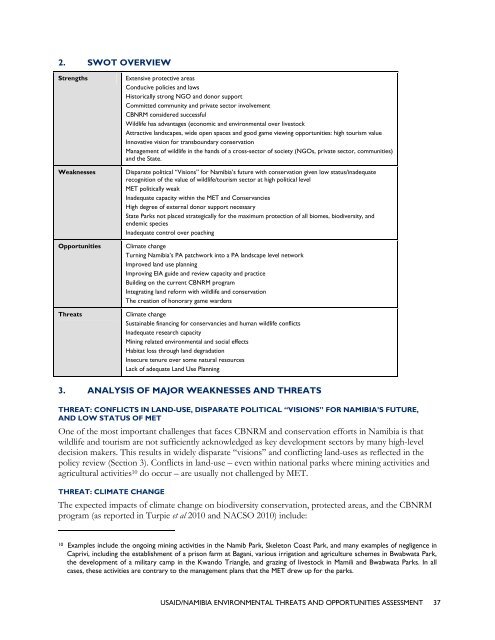usaid/nambia environmental threats and opportunities assessment
usaid/nambia environmental threats and opportunities assessment
usaid/nambia environmental threats and opportunities assessment
You also want an ePaper? Increase the reach of your titles
YUMPU automatically turns print PDFs into web optimized ePapers that Google loves.
2. SWOT OVERVIEW<br />
Strengths<br />
Weaknesses<br />
Opportunities<br />
Threats<br />
Extensive protective areas<br />
Conducive policies <strong>and</strong> laws<br />
Historically strong NGO <strong>and</strong> donor support<br />
Committed community <strong>and</strong> private sector involvement<br />
CBNRM considered successful<br />
Wildlife has advantages (economic <strong>and</strong> <strong>environmental</strong> over livestock<br />
Attractive l<strong>and</strong>scapes, wide open spaces <strong>and</strong> good game viewing <strong>opportunities</strong>: high tourism value<br />
Innovative vision for transboundary conservation<br />
Management of wildlife in the h<strong>and</strong>s of a cross-sector of society (NGOs, private sector, communities)<br />
<strong>and</strong> the State.<br />
Disparate political “Visions” for Namibia’s future with conservation given low status/inadequate<br />
recognition of the value of wildlife/tourism sector at high political level<br />
MET politically weak<br />
Inadequate capacity within the MET <strong>and</strong> Conservancies<br />
High degree of external donor support necessary<br />
State Parks not placed strategically for the maximum protection of all biomes, biodiversity, <strong>and</strong><br />
endemic species<br />
Inadequate control over poaching<br />
Climate change<br />
Turning Namibia’s PA patchwork into a PA l<strong>and</strong>scape level network<br />
Improved l<strong>and</strong> use planning<br />
Improving EIA guide <strong>and</strong> review capacity <strong>and</strong> practice<br />
Building on the current CBNRM program<br />
Integrating l<strong>and</strong> reform with wildlife <strong>and</strong> conservation<br />
The creation of honorary game wardens<br />
Climate change<br />
Sustainable financing for conservancies <strong>and</strong> human wildlife conflicts<br />
Inadequate research capacity<br />
Mining related <strong>environmental</strong> <strong>and</strong> social effects<br />
Habitat loss through l<strong>and</strong> degradation<br />
Insecure tenure over some natural resources<br />
Lack of adequate L<strong>and</strong> Use Planning<br />
3. ANALYSIS OF MAJOR WEAKNESSES AND THREATS<br />
THREAT: CONFLICTS IN LAND-USE, DISPARATE POLITICAL “VISIONS” FOR NAMIBIA’S FUTURE,<br />
AND LOW STATUS OF MET<br />
One of the most important challenges that faces CBNRM <strong>and</strong> conservation efforts in Namibia is that<br />
wildlife <strong>and</strong> tourism are not sufficiently acknowledged as key development sectors by many high-level<br />
decision makers. This results in widely disparate “visions” <strong>and</strong> conflicting l<strong>and</strong>-uses as reflected in the<br />
policy review (Section 3). Conflicts in l<strong>and</strong>-use – even within national parks where mining activities <strong>and</strong><br />
agricultural activities 10 do occur – are usually not challenged by MET.<br />
THREAT: CLIMATE CHANGE<br />
The expected impacts of climate change on biodiversity conservation, protected areas, <strong>and</strong> the CBNRM<br />
program (as reported in Turpie et al 2010 <strong>and</strong> NACSO 2010) include:<br />
10 Examples include the ongoing mining activities in the Namib Park, Skeleton Coast Park, <strong>and</strong> many examples of negligence in<br />
Caprivi, including the establishment of a prison farm at Bagani, various irrigation <strong>and</strong> agriculture schemes in Bwabwata Park,<br />
the development of a military camp in the Kw<strong>and</strong>o Triangle, <strong>and</strong> grazing of livestock in Mamili <strong>and</strong> Bwabwata Parks. In all<br />
cases, these activities are contrary to the management plans that the MET drew up for the parks.<br />
USAID/NAMIBIA ENVIRONMENTAL THREATS AND OPPORTUNITIES ASSESSMENT 37

















